(1979 to 1991)
Mercedes-Benz S-Class Model series 126
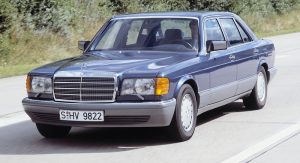
The transfer of technology from the S-Class to other Mercedes-Benz model series and to competitor vehicles before becoming the generally accepted technology standard continued in the years that followed, turning the S-Class into a genuine trendsetter. The airbag, now a key component of automotive safety, made its debut in 1981, in the model series 126 which had been launched two years earlier. Other features from this S-Class generation included the aerodynamically-enhanced shape and systematic weight reduction through the use of elements such as the new light-alloy V8 engines. The model series 126 also set the trend in terms of its design: it was the first Mercedes-Benz passenger car to do away with the traditional chrome bumpers in favour of deformable plastic ones built to withstand a ‘parking dent’. Initially felt by some observers to be plain and tasteless, the design of the model series 126 soon came to be regarded as timeless and elegant.
S-Class 126 model (1979 to 1991)
- Bodyshell with forked longitudinal member, first series production vehicle worldwide to meet the offset crash requirements
- Lower drag coefficient of cd = 0.37
- New V8 engines with light-alloy block
- Closed-loop catalytic converter as special equipment (from 1985) or standard fitment (from 1986)
- Electrically adjustable steering column as special equipment (from 1985)
- Driver airbag and belt tensioner for front passenger as special equipment (from 1981)
- Passenger-side air bag (from 1988)
- Automatic locking differential as special equipment for the six-cylinder models (from 1985)
- ASR (acceleration slip regulation) as special equipment for V8 models (from 1985)
- The most successful high-end, luxury Mercedes-Benz sedan
(1991 to 1998)
Mercedes-Benz S-Class Model series 140 (1991 to 1998)
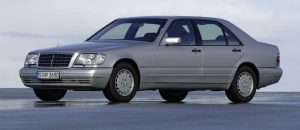
The S-Class of the model series 140 represented the new superlative at Mercedes-Benz in 1991. Its developers were aiming for maximum comfort, not least due to the larger dimensions and double glazing for optimum acoustic insulation. The top models, 600 SE and 600 SEL, were the first series production cars at Mercedes-Benz to feature a V12 engine. The entry model was the 300 SD turbo-diesel, which now brought luxury class to the diesel segment in the markets outside of North America too. This generation of the S-Class also introduced a pioneering safety innovation to the world of automotive engineering: the ESP® Electronic Stability Program which was fitted as standard on the V12 versions and was available as an option on the V8 models from 1995 onwards. The following year also saw the addition of the BAS Brake Assist System.
S-Class 140 model (1991 to 1998)
- Petrol engines with four-valve technology and variably adjustable inlet camshafts
- First Mercedes-Benz series production car with a twelve-cylinder engine, the brand’s most powerful passenger car engine up to that point (600 SE, 600 SEL)
- Premium-class diesel 300 SD available for the first time on the world markets
- Systematically designed for a high level of recyclability
- Total avoidance of chlorofluorocarbons
- Five-speed automatic transmission with electronic management (standard fitment for V8 and V12 models, from 1995)
- Parameter steering with speed-dependent steering torque
- Insulating double glazing on side windows for reduced noise
- Automatic climate control with activated charcoal filter and CO/NOX sensors as standard equipment (S 600) or special equipment
- Electrically folding exterior mirror
- Closing assist for doors and boot lid as special equipment
- Headlamps with variable-focus reflectors
- Electronics linking via CAN-bus
- Restraint system with automatic height adjustment
- Side airbags for driver and front passenger (from 1996)
- Adaptive damping system (ADS) as special equipment
- Electronic Stability Program (ESP® ) as standard equipment (S 600, from 1995) or special equipment (S 420, S 500, from 1995)
- Brake Assist (BAS, from 1996)
- PARKTRONIC electronic parking aid as standard equipment (S 600, from 1995) or special equipment (from 1995)
- Auto Pilot System (APS) navigation system as special equipment (from 1995)
- TELE-AID emergency call system as special equipment (from 1997)
- LINGUATRONIC voice control system as special equipment (from 1996)
- Xenon headlights with dynamic headlamp range control as special equipment (from 1996)
(1998 to 2005)
Mercedes-Benz S-Class Model series 220
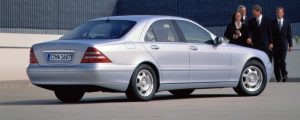
After the model change in 1998, the appearance of the new S-Class (model series 220) was all about understatement. Weight saving and a further increase in safety and comfort were among the primary development goals. Despite having to abandon weight-intensive features such as double glazing, the new model generation offered even greater comfort, not least due to the new electronically controlled AIRMATIC air suspension, COMAND control and display system, and innovative DISTRONIC proximity-controlled cruise control system. Active Body Control (ABC), which was available from 1999, reduced body roll for an as yet unsurpassed level of driving dynamics. The interior design which, for the first time, had been developed in close conjunction with the exterior, created an inimitable ambience in the S-Class. The first AMG model to officially make its way into the S-Class price list, the S 55 AMG appealed to customers with a passion for speed. Even the regular high-end model without the AMG sports badge, the S 600, had its performance boosted in autumn 2002, making it capable of reaching the magical 368 kW (500 hp) mark for the first time ever. At the same time, the model series 220 saw the introduction of another ground-breaking innovation: the PRE-SAFE preventive occupant safety system. This system enabled the vehicle to prepare occupants for an imminent collision by automatically initiating measures for their optimum protection. As part of the model refinement, the S-Class could now also be equipped with intelligent 4MATIC permanent all-wheel drive for the first time.
S-Class 220 model (1998 to 2005)
- Lightweight body with weight-reducing materials mix (high-tensile steel, light alloy, plastic)
- Aluminium crash boxes in the front end and rear structure
- Drag coefficient cd = 0.27
- Automatic cylinder cut-out system as standard equipment (S 600) or special equipment (S 500)
- Seven-speed 7G-TRONIC automatic transmission with electronic management (S 430, S 500, from 2004)
- AIRMATIC air suspension with electronically controlled adaptive damping system ADS
- Active Body Control ABC as special equipment (standard fitment on the S 600)
- Additional turn signal lamps integrated into the wing mirrors
- Auto on/off headlamps
- COMAND control and display system with dynamic navigation system as special equipment
- Window bags
- Rear Side bags
- Passenger-side air bag with two-stage gas generator
- Rear belt tensioner and belt force limiter
- Side windows with laminated glass
- Multizone automatic climate control with solar-dependent settings for individual seats
- Luxury seats with ventilation and dynamic multi-contour backrest as special equipment
- DISTRONIC proximity control as special equipment
- KEYLESSGO keyless access and drive authorisation system as special equipment
- Bi-xenon headlights with dynamic headlamp range control as special equipment (from 2002, standard fitment on the S 600)
- PRESAFE® preventive occupant safety system (from 2002)
- V8 diesel engine with light alloy block (S 400 CDI)
- 4MATIC permanent all-wheel drive as special equipment (S 430, S 500, from 2002)
Gallery

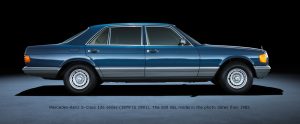
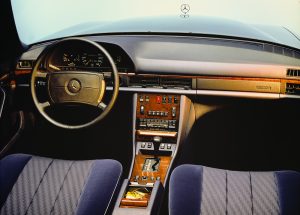
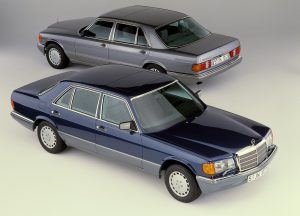

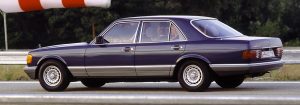
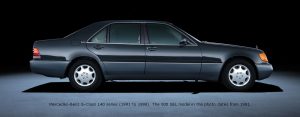

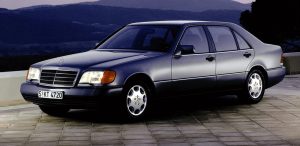
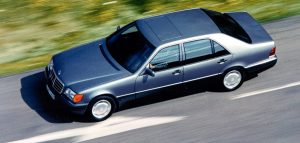

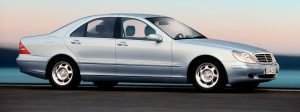
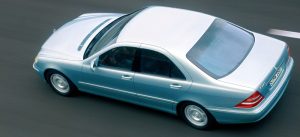
You must be logged in to post a comment.